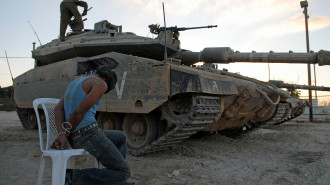The Gulf's Towering Firetraps
The spectacular blaze that swept through the 79 storey Torch tower in Dubai, one of the tallest residential buildings in the world, spread with astonishing rapidity, thanks to high winds and the ease with which the exterior panels of the skyscraper burst into flame.
The unfortunately-named Torch burnt for several hours with panels, called cladding, breaking off and plunging to the ground.
There were no casualties, but once again questions need to be asked about the exterior facades used in the Gulf, home to some of the most spectacular high-rise towers in the world.
Dubai fire guts 79-floor skyscraper. Read more. |
According to construction experts, many of those towers are sheathed in highly flammable material. And most of the occupants will be unaware that they may be living or working in what are effectively towering firetraps.
'Like a Roman candle'
One expert in the UAE has estimated that 70% of the high-rise buildings there have panel facade cladding made of a combustible thermoplastic core held between two sheets of aluminium.
| Questions need to be asked about the exterior facades used in the Gulf, home to some of the most spectacular high-rise towers in the world. |
When the panel ignites, fire spreads rapidly, racing to the top of the building and sending flaming debris hurtling to the streets below. "Like a Roman candle" is how one observer described it.
One of the Torch tower residents, who escaped the blaze unharmed, provided the BBC with this telling description:
"Those panels were catching fire and then coming off the building and being picked up by the wind, they were falling down on to the street still in flames, they weren't going out and they were actually knocking into the buildings across the road."
Although there is no indication yet of what caused the Torch blaze, it could be something as simple as a discarded cigarette butt or a charcoal barbecue left unattended on a balcony.
A fire at the al-Hafeet Tower in Sharjah in April 2013 was eerily similar to a blaze that gutted the Tamweel Tower in Dubai November 2012. And the 40-storey al-Tayer tower in Sharjah also suffered a similar fate earlier that year.
In all those cases, as with the Torch fire, flames roared up the sides of the building as individual panels ignited. No deaths were reported from any of the fires.
"[The facades] are good-looking, long-lasting and easy to maintain, but they have one big problem - they burn rapidly," Thom Bohlen, of the Dubai-based Middle East Centre for Sustainable Development, said.
Bohlen, the institute's chief technical officer, said the UAE has passed new legislation banning the use of flammable facades, but it only applies to new building construction.
"That doesn't take care of the problem with current buildings", he said, adding the costs of refits will be "extremely expensive". The Torch tower took more than five years to build and opened in 2011.
Bohlen estimates that "at least 500 buildings" in UAE cities are sheathed in the flammable panels. The difficulty is that no one is sure which buildings have the flammable cladding and which do not.
The flammable sheathing has not been used in the UK since the 1980s and codes in the United States specifically prohibit them on buildings of more than three or four storeys. There is fire resistant cladding, which has been used for several decades in those and other countries but it is much more expensive. Lax codes and weak enforcement in the Gulf have allowed for the cheaper flammable material to be used there.
Bohlen is not alone in voicing concerns about the risk of fire in many of the high-rise towers that pepper every major Gulf city - or about the failure to pin down what is causing so many fires.
At a health and safety conference in Doha, the capital of Qatar, another expert spoke of a huge number of fire incidents that had not been properly investigated.
Steve Wood, the safety and health director for the Middle East division of the giant US technology corporation AECOM presented delegates with an alarming figure: in 2012 alone the causes of more than 1,000 fires in Qatar remained unknown.
| Bohlen estimates that "at least 500 buildings" in UAE cities are sheathed in the flammable panels. |
"The reason why it's not known is maybe because they are too busy extinguishing fires and not resourced enough to investigate them," he is quoted as saying.
Qatar, with its huge hydrocarbon reserves, is per capita the wealthiest country in the world. It has spent billions of dollars in recent years on enormous building projects that have radically transformed the Doha skyline. But it appears that insufficient money was set aside for fire investigation.
Weak enforcement
Like other Gulf countries, Qatar has regulations and legislation on the books, mostly modelled on the US and the UK, but at the conference Steve Wood was quoted as saying codes are open to interpretation.
"Some clients may go for the least strict requirements, thinking 'which ones are the least I need to comply?'" he said.
Bohlen said the unprecedented growth of Gulf cities has meant that though the buildings go up with astonishing speed, regulation and adequate enforcement lag behind.
That is because codes are simply adopted from other countries, but the context and enforcement mechanisms in which those codes developed are often missing or lacking in comprehensive application.
"There is not a lot of code depth in the Gulf. Codes are borrowed and it takes a long time to develop [the context]. They are coming but they haven't caught up," he said.
Occupants of residential towers that burst into flames have praised the quick response time of firefighters but most seem unaware that they and their families may be living in potential firetraps. And although some Gulf governments have expressed concerns and are revising and updating their practices, safety still appears to be taking a back seat in the headlong rush to build.
Lax enforcement of regulations, inadequate fire codes, a lack of rigorous post-blaze investigation, a construction industry that has all too often taken shortcuts - all these factors have enabled skyscrapers to be built without due regard for the people who live or work in them.
Thus far there have been no serious casualties but experts like Bohlen argue it is only a matter of time before a high-rise Gulf skyscraper turns into a towering inferno with lethal consequences.







 Follow the Middle East's top stories in English at The New Arab on Google News
Follow the Middle East's top stories in English at The New Arab on Google News


